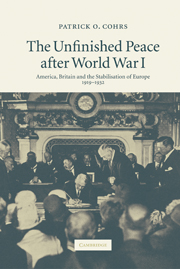Book contents
- Frontmatter
- Contents
- Acknowledgements
- List of abbreviations
- A note on the footnotes and bibliography
- Introduction
- Prologue
- 1 The wider challenges
- 2 Wilson, Lloyd George and the quest for a ‘peace to end all wars’
- 3 The ill-founded peace of 1919
- 4 The escalation of Europe's post-Versailles crisis, 1920–1923
- Part I The Anglo-American stabilisation of Europe, 1923–1924
- 5 Towards a Progressive transformation of European politics
- 6 Towards transatlantic co-operation and a new European order
- 7 The turning-point
- 8 From antagonism to accommodation
- 9 The two paths to the London conference
- 10 The first ‘real’ peace settlement after World War I
- Part II Europe's nascent Pax Anglo-Americana, 1924–1925
- Part III The unfinished transatlantic peace order: the system of London and Locarno, 1926–1929
- Epilogue
- Conclusion
- Map: Post-World War I Europe after the peace settlement of Versailles
- Bibliography
- Index
8 - From antagonism to accommodation
The reorientation of French and German postwar policies, 1923–1924
Published online by Cambridge University Press: 21 July 2009
- Frontmatter
- Contents
- Acknowledgements
- List of abbreviations
- A note on the footnotes and bibliography
- Introduction
- Prologue
- 1 The wider challenges
- 2 Wilson, Lloyd George and the quest for a ‘peace to end all wars’
- 3 The ill-founded peace of 1919
- 4 The escalation of Europe's post-Versailles crisis, 1920–1923
- Part I The Anglo-American stabilisation of Europe, 1923–1924
- 5 Towards a Progressive transformation of European politics
- 6 Towards transatlantic co-operation and a new European order
- 7 The turning-point
- 8 From antagonism to accommodation
- 9 The two paths to the London conference
- 10 The first ‘real’ peace settlement after World War I
- Part II Europe's nascent Pax Anglo-Americana, 1924–1925
- Part III The unfinished transatlantic peace order: the system of London and Locarno, 1926–1929
- Epilogue
- Conclusion
- Map: Post-World War I Europe after the peace settlement of Versailles
- Bibliography
- Index
Summary
Why had Poincaré in the end effectively accepted US conditions? Had he simply ceded to America's overwhelming financial pressure? Why did he fail to capitalise on France's seemingly strong position after the cessation of German passive resistance? And why had Stresemann endorsed the Anglo-American proposal so unequivocally? Answers to these questions are more complex than is prima facie apparent. They are in fact inextricably linked with two further questions. Why did the Anglo-American intervention become so decisive? And why was it that between Poincaré's shift and the 1924 London conference the European constellation – and transatlantic politics – was so fundamentally altered? All of these questions can be re-appraised by focusing not only on the behaviour of national policymakers, however important their decisions and domestic constraints. A more comprehensive explanation results from shifting to a systemic analysis of the now rapidly changing international configuration. To be asked is: who shaped the ground-rules of the Dawes process and, more generally, international politics from December 1923?
The answer is twofold: obviously, the United States, and, more subtly, Britain. As Washington's indispensable ‘interest and influence’ was to be engaged only on American terms, there was a clearly prevalent trend in 1924. What began to transform Euro-Atlantic relations was Hughes' strategy of ‘depoliticisation’, not Curzon's old-style diplomacy or the Versailles-based designs that Poincaré tried to re-assert until his electoral defeat in May 1924.
- Type
- Chapter
- Information
- The Unfinished Peace after World War IAmerica, Britain and the Stabilisation of Europe, 1919–1932, pp. 116 - 128Publisher: Cambridge University PressPrint publication year: 2006



